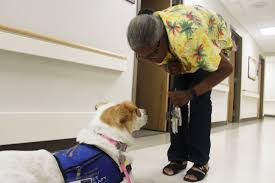Oftentimes, the best part of my day is coming home to the long snout and warm panting breath of my dog. The rhythmic thumping of his tail matches the beating of my heart, bringing me unbridled joy. Many pet owners share similar sentiments and know that animals can bring love and companionship into our lives. But our furry friends also have the potential to keep us healthier and live longer lives.
Animal Assisted Therapy (AAT) has roots dating back thousands of years with reports of the Ancient Greeks using horses to raise the spirits of the incurably ill in attempts to promote better prognoses [1]. This was noted more formally in the 1800s when Florence Nightingale, widely recognized as the founder of modern nursing, began recommending the use of small animals with the chronically ill. She wrote, “A small pet animal is often an excellent companion for the sick, for long chronic cases especially. A pet bird in a cage is sometimes the only pleasure of an invalid confined for years to the same room” [2]. However, it wasn’t until the mid-1960s that formal animal therapy studies began and the practice became recognized and respected. Dr. Boris Levinson coined the term “Pet Therapy” in 1964 after discovering that using his dog, Jingles, in therapy sessions made children more comfortable and likely to socialize, even prompting non-verbal children to begin communicating [3]. After publishing his book “Pet Oriented Child Psychotherapy” the field of AAT has blossomed and is modernly used in psychiatry, geriatrics, and cardiology.
Presently, AAT is most widely used in psychiatry and psychology. In a 2012 paper summarizing the use of AAT, it was found to be predominantly used in cases of depression, anxiety, addiction, schizophrenia and autism spectrum disorder. The paper reported AAT was particularly effective in improving social and communication skills, easing anxiety, improving mood, facilitating independent living, and improving empathic skills [4]. This is commonly seen amongst military personnel. In a 2018 study involving military veterans with diagnosed cases of PTSD, vets with service dogs reported a 22 percent higher rate of life satisfaction, as well as similarly increased rates of mental health, resilience, and ability to participate in social activities. At the same time, they reported fewer PTSD symptoms and lower levels of depression [5]. These benefits are not limited to canines, however, as multiple studies have recently documented the use of horses in improving symptoms in victims of trauma or sexual assault, as well as the use of gerbils and aquarium tanks to calm patients prior to procedures.
One particular group in which AAT use has increased is seniors. Pets have long been used to ease the social pain of aging, preventing loneliness and reducing stress. Now those benefits are beginning to be formally researched. In a 2013 study involving a group of geriatric nursing home residents, it was reported that participants who were provided with 90 minutes of dog companionship three times weekly had a significantly reduced perception of loneliness both during and after the visits, compared to control groups, as measured by the UCLA loneliness scale [6]. Additional studies have shown that AAT sessions even as short as 15 minutes can reduce cortisol levels in seniors while raising levels of “feel good hormones” serotonin, oxytocin, and prolactin.
The physiological benefits of AAT are now beginning to be utilized in more traditional medical fields, such as cardiology. Numerous studies have explored the relationship between pet ownership and cardiovascular disease, detailing increased physical activity levels, decreases in systemic blood pressure, cholesterol levels, and triglyceride levels as well as significantly improved survival rates after acute coronary syndrome. In 2013, The American Heart Association released a statement concluding that pet ownership, particularly of dogs, is associated with decreased risk of cardiovascular disease and may play a causal role in that reduction (evidence grade: B) [7]. In addition to contributing to a healthier lifestyle, these benefits extend into the traditional hospital setting as well. In a 2011 pilot study on patients hospitalized for advanced heart failure, it was demonstrated that patients who received canine assisted ambulation started to walk sooner and further than those who did not walk with the dog team. The authors concluded that canine assisted ambulation has the potential to shorten hospital stays and improve long term prognoses in patients [8].
After centuries of anecdotal evidence, animal assisted therapy is beginning to be studied and used in modern medical treatments. It’s now seen in many fields. Given its known psychological benefits, it has the potential to be used in a vast spectrum of diseases and treatments as an augment to traditional therapies.
- Lazenby FD. Greek and Roman Household Pets. http://penelope.uchicago.edu/Thayer/E/Journals/CJ/44/4/Household_Pets*.html. Accessed September 8, 2019.
- Nightingale, F. Notes on nursing: What it is, and what it is not. New York: Dover, 1969. P.103
- Coren S. How therapy dogs almost never came to exist. Psychology Today. psychologytoday.com. Published February 11, 2013. Accessed September 8, 2019
- Bánszky N, Kardos E, Rózsa L, Gerevich J. The psychiatric aspects of animal assisted therapy [in Hungarian]. Psychiatr Hung. 2012;27(3):180-190.
- O’Haire, ME, Rodriguez, K. E. Preliminary efficacy of service dogs as a complementary treatment for posttraumatic stress disorder in a military population. J Consult Clin Psychol. 2018 Feb;86(2):179-188. doi: 10.1037/ccp0000267
- Vrbanac Z, Zecević I, Ljubić M, et al. Animal assisted therapy and perception of loneliness in geriatric nursing home residents. Coll Antropol. 2013;37(3):973-976
- Levine GN, Allen K, Braun LT, et al; American Heart Association Council on Clinical Cardiology; Council on Cardiovascular and Stroke Nursing. Pet ownership and cardiovascular risk: a scientific statement from the American Heart Association. Circulation. 2013;127(23):2353-2363.
- Abate S, Zucconi M, Boxer B. Impact of canine-assisted ambulation on hospitalized chronic heart failure patients’ ambulation outcomes and satisfaction: a pilot study. J Cardio Nurs. 2011;26(3):224-230.
Arjun Johal is a member of The University of Arizona College of Medicine – Phoenix Class of 2023. He graduated from the University of California at Santa Barbara in 2016 with a major in Biochemistry and a minor in English. In his free time he enjoys anything that gets him moving, whether it be a bicycle, a surfboard, or anything in between. He also welcomes discussion on topics of all ranges, ideally over a cup of tea. Feel free to contact him at arjunjohal[at]email.arizona.edu


